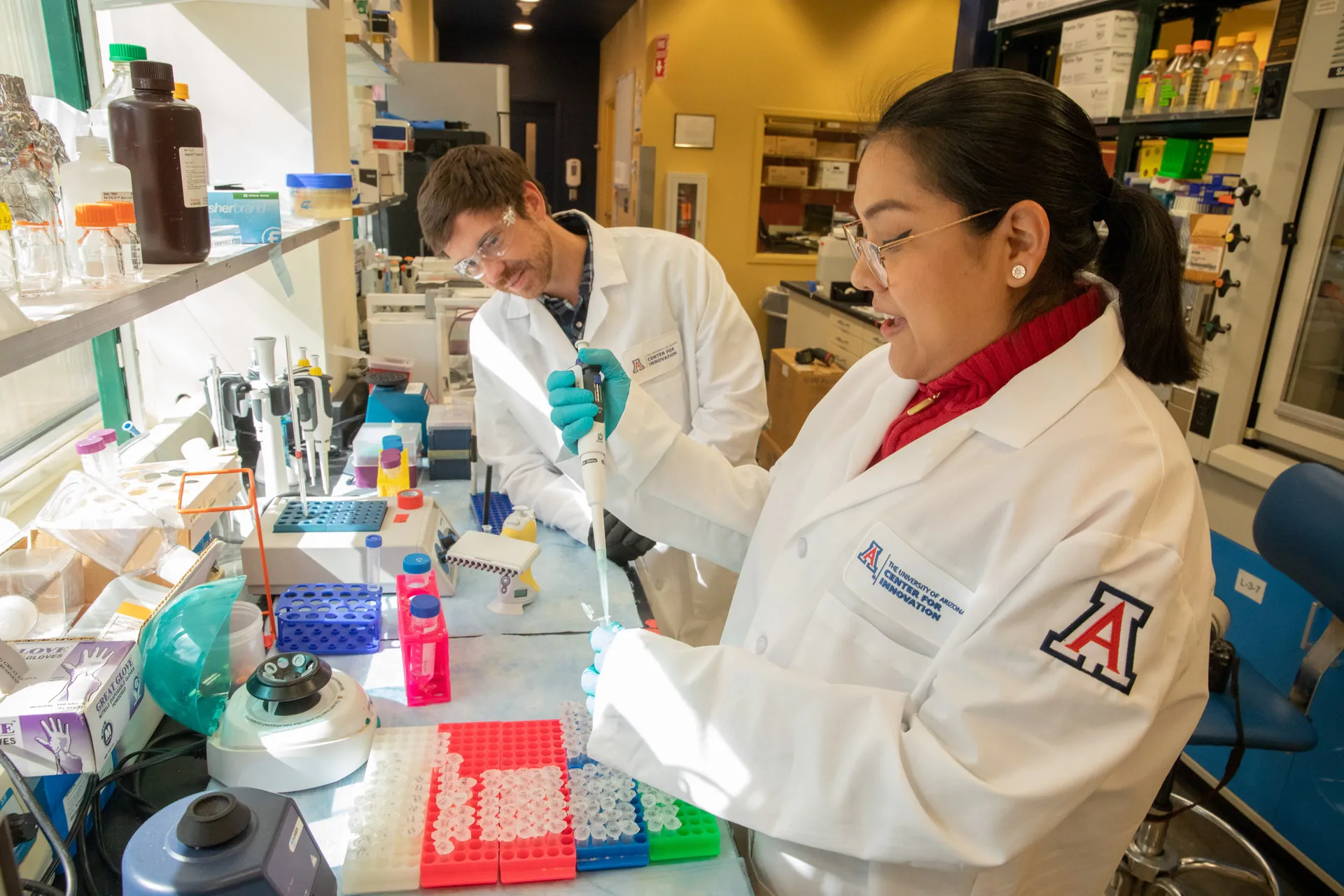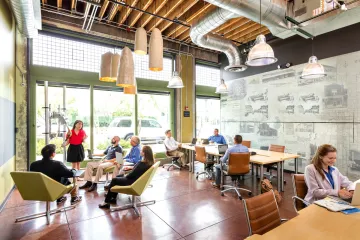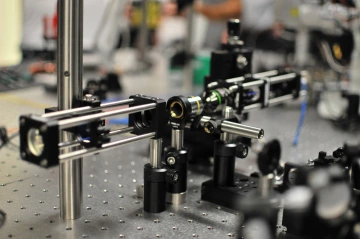Innovation Revolution
Celebrating the Entrepreneurial Spirit

Startups working in UA Center for Innovation lab at UA Tech Park
Chris Richards
Optical technology helping the legally blind to see and systems permitting patients to manage their pills. Paradigm-shifting traffic-flow schemes and sustainable alternatives to rubber production. At the University of Arizona, innovation is powering a steady stream of ideas and discoveries that translate into market-ready solutions designed to make a difference.
It could be called an innovation revolution, and it’s happening in large part through the university’s Office of Research, Innovation and Impact, or RII. Underlying this revolution is a profound commitment to the state of Arizona’s economic vitality, societal well-being and human resilience.
RII supports the world-class research enterprise at UArizona, which is ranked by the National Science Foundation among the top 20 public universities nationwide with more than $824 million in research activity.
“Companies and organizations from across Arizona and outside of Arizona look at us as knowledge creators and developers of a knowledgeable and well-trained workforce,” says Betsy Cantwell, RII’s senior vice president. “Research at the University of Arizona is the beginning of an innovation ecosystem cycle that then comes back to us in the form of either new faculty or new business partners.”
Important drivers in RII’s innovation ecosystem include Tech Launch Arizona, responsible for shepherding campus-generated inventions to market; Tech Parks Arizona, which provides the physical space and key support for startups and established companies to flourish; the UA Center for Innovation, a startup incubator network; and Arizona FORGE (Finding Opportunities and Resources to Grow Entrepreneurs), which cultivates an entrepreneurial mindset in all students and communities where the university operates.
LAND-GRANT MISSION
Innovation with regional relevance dovetails with UArizona’s role as a land-grant university — one among the dozens of public learning institutions designated beginning in the 19th century to meet a growing demand for agricultural and technical education as well as classical studies. These schools were financed through the sale of federal land deeded to states, and they have a mission to serve.
Today, that mission permeates RII, says Cantwell. “We do research, very specifically, to grow our capacity to serve our community and the state,” she says. And the result is remarkable: Between fiscal years 2013 and 2022, UArizona faculty generated 2,455 potentially marketable invention ideas and initiated nearly 500 licenses for moving campus-generated research and technology to market. This innovation revolution has also helped generate 130 startup companies, and university research resulted in nearly 600 U.S. patents. This kind of activity also promotes workforce development in a big way, having resulted in the addition of nearly 2,500 high-tech sector jobs.
Among the university’s latest successes is a $35 million collaboration with tire giant Bridgestone Americas with the goal of developing rubber from the desert shrub guayule. The plant could offer not only a sustainable rubber source but also a low-water crop alternative for Arizona’s drought-stricken farmers.
That cooperative effort also highlights RII’s emphasis on adaptability in the face of changes in the climate — and in society. “One of our major research goals is to make Arizona a resilient state,” Cantwell says. “We’re prodigious in environmental resilience and climate change, but also in the business, legal, social and ethical issues that support resilience.”
All this work has made UArizona a global leader in research and innovation, ranking it among the top 1% of universities worldwide and 28th among the world’s top 100 invention-patenting universities.
TECH LAUNCH ARIZONA
While UArizona has always been a research powerhouse, its role as an innovation leader can be traced back to 2012, when Tech Launch Arizona (TLA) was founded to help commercialize campus-created inventions.
In just the past five years, TLA has produced more than $1.6 billion in economic impact, and achieving that level of success requires constantly scouting across the university for new ideas, says Douglas Hockstad, TLA’s associate vice president.

An innovation revolution is underway at UArizona.
160/90 photo
“We have licensing managers embedded in the colleges, and they’re talking to the researchers all the time to understand what they’re working on, what’s of relevance to create potential marketable impact and whether there is something resulting from their research that should be disclosed to TLA so that we can start to loop them into the process,” he says. If the answer is “yes,” that project proceeds through through a market analysis, a patent landscape search, and consultations with potential marketing partners.
Other times, a campus inventor proactively approaches TLA to obtain support in creating a startup. Then the venture development team steps in, and its focus turns to helping the budding company build a leadership team and develop its initial go-to-market strategy.
“That’s really where we do a lot of engagement with the ecosystem,” Hockstad says. “Creating momentum and interest around every startup project to move it forward.”
Sometimes, this involves collaborations with outside venture capitalists, such as UArizona alumnus Fletcher McCusker ’74, founder of several successful startups, including the medication therapy management company Sinfonía Healthcare.
Working with TLA, McCusker created Sinfonía with a leadership team that included UArizona nursing-school graduate Danielle Sipe ’05 — later the company’s clinical services director — and UArizona College of Medicine graduate Christian Moher ’99, who served as its chief medical officer. The idea for Sinfonía actually started with Kevin Boesen ’96, founder of the Medication Management Center at the College of Pharmacy, who created cutting-edge software to help people manage their proliferous prescriptions.
After Sinfonía, McCusker went on to launch UAVenture Capital with the goal of commercializing UArizona science, technology and services products. “We’ve now invested over $40 million in related technologies,” he says. “We’ve found an unbelievable audience for these very disruptive technologies.”
This campus-business integration, led by RII and supported by units like TLA, is putting Tucson on the business map, says McCusker.
“It has created a thriving environment for companies that want to relocate, that are looking for talent for startup kind of activities. And for the first time that I can remember, we now have venture capital available in Tucson,” he says.
TECH PARKS ARIZONA AND THE UA CENTER FOR INNOVATION
Innovators often need physical space and an interactive and supportive environment to flourish. At UArizona, that happens through Tech Parks Arizona, comprised of the 1,300-acre UA Tech Park at Rita Road on Tucson’s east side, the new 65-acre UA Tech Park at The Bridges on the south side of Tucson, and a startup incubator network called the UA Center for Innovation. They rank among the nation’s premier facilities.
The spaces have proven to be a huge draw, says Tech Parks Arizona Vice President Carol Stewart. “We now have over 6,000 knowledge workers and the largest concentration of startups anywhere in the state.”
Tech Parks Arizona’s more than 100 tenants, including tech giants and startups, benefit from the business infrastructure provided in the spaces, from offices and conference rooms to research and development labs. The companies work in fields such as optics, bio and life sciences, and aerospace and defense.
The UA Tech Park at Rita Road also is home to Solar Zone, a groundbreaking renewable energy development. Operated in partnership with Tucson Electric Power, Solar Zone is one of the largest multitechnology grid-level solar demonstration sites in the United States.
Additionally, RII’s Mission Integration Lab — its first facility for balloon-borne astronomical study, located at the UA Tech Park at The Bridges — signals the potential to attract new NASA and aerospace industry research collaborations. This positions the university as one of only a handful of institutions that can run top-dollar missions.
The Tech Parks produce a $2 billion annual economic impact in Arizona, Stewart says, and that influence continues to grow. Part of the current effort includes plans to add startup incubators in rural communities across Arizona.
“I go all around the world talking about the University of Arizona, and everybody knows what’s going on here,” she says. “We have companies that come in and want to be affiliated with us. They want to work with us to access the right kind of talent.”
Talent can likewise get a head start at the UA Center for Innovation, a science and technology business incubator headquartered at the UA Tech Park at Rita Road. UACI provides customized support to startup entrepreneurs working side by side in what Executive Director Eric Smith ’12 ’18 calls “a fast-moving, collaborative and creative environment.”

“Our job as a startup incubator is to work with scalable science and tech ventures,” he says. “The typical profile is that they’re working on something new and they’re looking to fundraise. These types of startups need a lot of support, and we provide a significant amount of programming. We help them implement their ideas through a 27-point roadmap and provide specialized lab and office space.”
The center has worked with thousands of entrepreneurs and over 250 startups in its 20 years. “And if we do our job right,” Smith says, “they then attract capital to the region. They hire people in the region, and they purchase infrastructure here.”
Currently, 46% of UACI startups have a university affiliation, whether through alumni and graduate student connections or innovations that originated from university research.
As an incubator network, UACI has four additional outposts — at Biosphere 2 and in Sahuarita, Oro Valley and Vail — and is set to expand to Sierra Vista and the UA Tech Park at The Bridges.
FORGE
This innovation ecosystem also builds student resilience through programs like Arizona FORGE. Headquartered in downtown Tucson’s historic Roy Place Building, FORGE launched in 2019 with a core mission that includes cultivating entrepreneurial thinking, advancing the entrepreneurial ecosystem and driving the scale-up and launch of entrepreneurial projects.
FORGE is leading the charge with programs and events for entrepreneurially minded students, robust outreach to big thinkers across campus and beyond, and a visionary alum driving potent business collaborations.
Tools toward that end include Venturing 101, which provides short courses on launching a business venture. There’s also the Biomedical Entrepreneur Startup Scholarship and Residency, which assists with health related student venture ideas, and Native FORGE, a five year project to boost Native American startups in Arizona.
FORGE now has a half-dozen locations in Phoenix and Southern Arizona, anchoring a network of mentors from a broad variety of industries. Those mentors-in-residence currently range from general management and tech executive Shefali Patel and real estate expert and restaurant investor Rashaad Whittington to Brian Ellison, founder of the business consulting group Preston-Douglas. In addition, new participants in the FORGE Ahead accelerator program include sports-psychology coaching and education company MindReady.
Brian Ellerman ’00 ’21 brings a background as an angel investor that makes him a perfect fit as FORGE’s founding executive director. He says his goal is to foster the entrepreneurial mindset in its very early stages. Step 1: piercing preconceived notions. “You say ‘entrepreneur’ to most people, and they think ‘founder’ and all that comes along with that. But with a group of students, you ask how many of them have a side hustle, and nearly every hand goes up. They’re making T-shirts or working side jobs. Why do they see that as different from planning to start a company?”
In other words, more students than ever before innately grasp the fundamentals of entrepreneurship.
“We help them understand that being entrepreneurially minded has to do with critical thinking, problem solving and psychological resilience,” Ellerman says.
No matter where you go on campus, innovative ideas — and the potential impact of those ideas — are percolating.
“This is how you begin to grow the economic and societal value of what the university does,” Cantwell says. “You work with regions and communities. You elevate them and make them stronger, which in turn empowers students who are going to come to our university and bring their own creative ideas.”
Now that’s a revolution to believe in.
Connect with the Wildcat Investor Network
Invest your time, talent or treasure in the next generation of founders - University of Arizona students.
